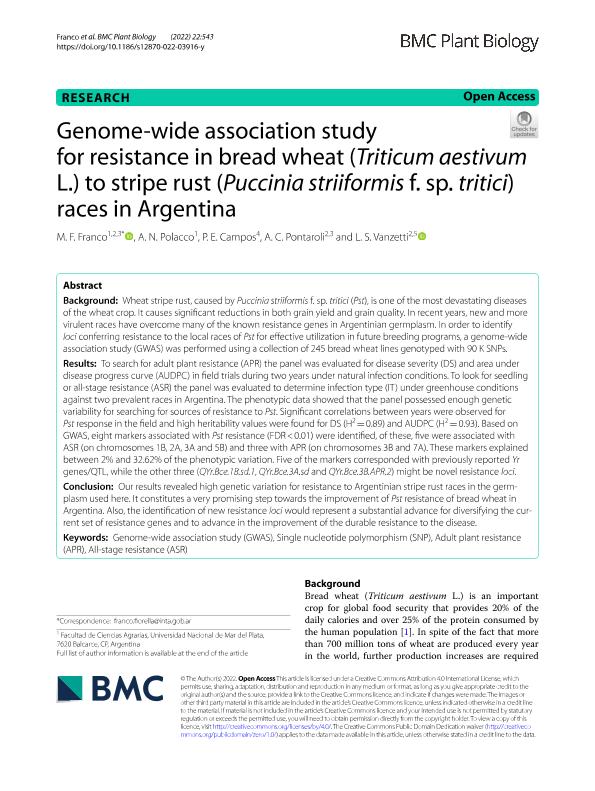Artículo
Genome-wide association study for resistance in bread wheat (Triticum aestivum L.) to stripe rust (Puccinia striiformis f. sp. tritici) races in Argentina
Franco, María Fiorella ; Polacco, A. N.; Campos, P. E.; Pontaroli, Ana
; Polacco, A. N.; Campos, P. E.; Pontaroli, Ana ; Vanzetti, Leonardo Sebastián
; Vanzetti, Leonardo Sebastián
 ; Polacco, A. N.; Campos, P. E.; Pontaroli, Ana
; Polacco, A. N.; Campos, P. E.; Pontaroli, Ana ; Vanzetti, Leonardo Sebastián
; Vanzetti, Leonardo Sebastián
Fecha de publicación:
11/2022
Editorial:
BioMed Central
Revista:
BMC Plant Biology
ISSN:
1471-2229
Idioma:
Inglés
Tipo de recurso:
Artículo publicado
Clasificación temática:
Resumen
Background: Wheat stripe rust, caused by Puccinia striiformis f. sp. tritici (Pst), is one of the most devastating diseases of the wheat crop. It causes significant reductions in both grain yield and grain quality. In recent years, new and more virulent races have overcome many of the known resistance genes in Argentinian germplasm. In order to identify loci conferring resistance to the local races of Pst for effective utilization in future breeding programs, a genome-wide association study (GWAS) was performed using a collection of 245 bread wheat lines genotyped with 90 K SNPs. Results: To search for adult plant resistance (APR) the panel was evaluated for disease severity (DS) and area under disease progress curve (AUDPC) in field trials during two years under natural infection conditions. To look for seedling or all-stage resistance (ASR) the panel was evaluated to determine infection type (IT) under greenhouse conditions against two prevalent races in Argentina. The phenotypic data showed that the panel possessed enough genetic variability for searching for sources of resistance to Pst. Significant correlations between years were observed for Pst response in the field and high heritability values were found for DS (H2 = 0.89) and AUDPC (H2 = 0.93). Based on GWAS, eight markers associated with Pst resistance (FDR < 0.01) were identified, of these, five were associated with ASR (on chromosomes 1B, 2A, 3A and 5B) and three with APR (on chromosomes 3B and 7A). These markers explained between 2% and 32.62% of the phenotypic variation. Five of the markers corresponded with previously reported Yr genes/QTL, while the other three (QYr.Bce.1B.sd.1, QYr.Bce.3A.sd and QYr.Bce.3B.APR.2) might be novel resistance loci. Conclusion: Our results revealed high genetic variation for resistance to Argentinian stripe rust races in the germplasm used here. It constitutes a very promising step towards the improvement of Pst resistance of bread wheat in Argentina. Also, the identification of new resistance loci would represent a substantial advance for diversifying the current set of resistance genes and to advance in the improvement of the durable resistance to the disease.
Archivos asociados
Licencia
Identificadores
Colecciones
Articulos(SEDE CENTRAL)
Articulos de SEDE CENTRAL
Articulos de SEDE CENTRAL
Citación
Franco, María Fiorella; Polacco, A. N.; Campos, P. E.; Pontaroli, Ana; Vanzetti, Leonardo Sebastián; Genome-wide association study for resistance in bread wheat (Triticum aestivum L.) to stripe rust (Puccinia striiformis f. sp. tritici) races in Argentina; BioMed Central; BMC Plant Biology; 22; 1; 11-2022; 1-17
Compartir
Altmétricas



